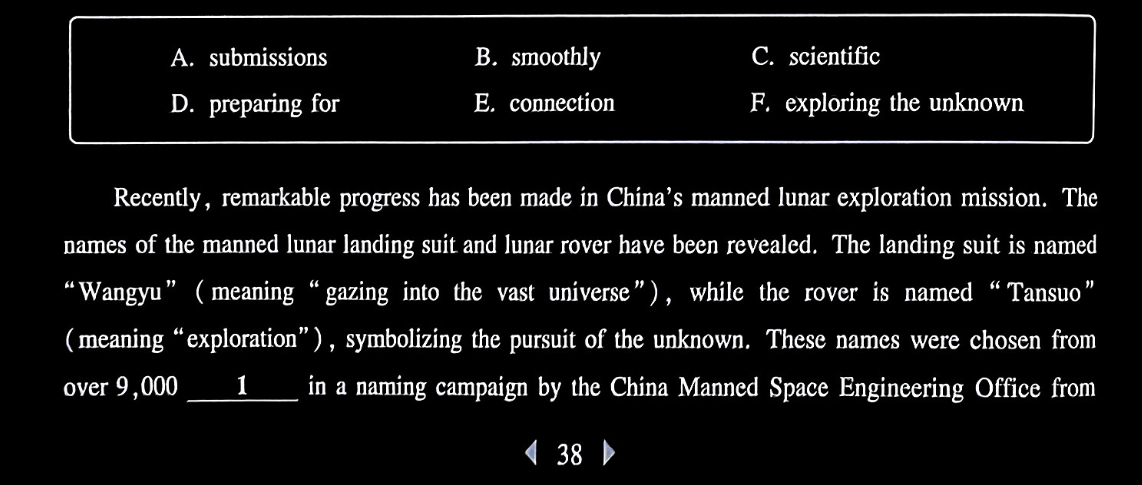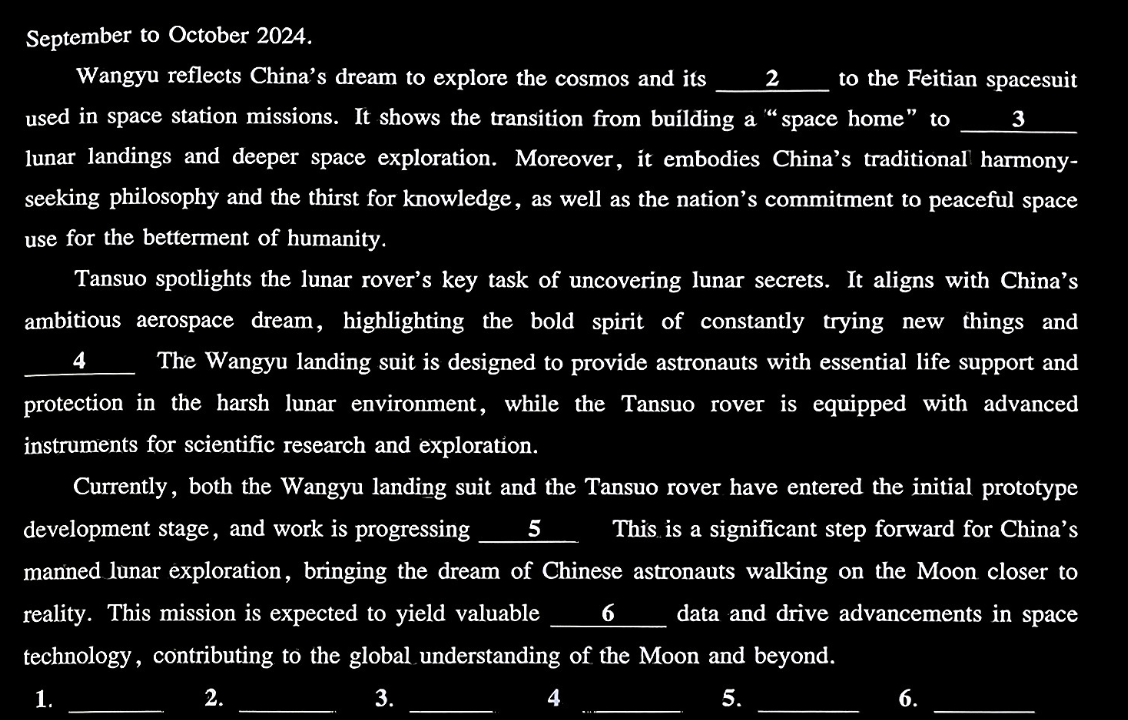

Recently, remarkable progress has been made in China's manned lunar exploration mission.
最近,中国载人登月探索任务取得了显著进展。
The names of the manned lunar landing suit and lunar rover have been revealed.
登月服和月球车的名称已被揭晓。
The landing suit is named “Wangyu” (meaning “gazing into the vast universe"), while the rover is named “Tansuo” (meaning “exploration”), symbolizing the pursuit of the unknown.
登月服命名为“望远”(意为“凝望浩瀚宇宙”),而月球车命名为“探索”(意为“探索”),象征着对未知的追求。
These names were chosen from over 9,000 submissions in a naming campaign by the China Manned Space Engineering Office from September to October 2024.
这些名称是在2024年9月至10月期间,中国载人航天工程办公室举办的命名活动中,从超过9000个提名中选出的。
Wangyu reflects China's dream to explore the cosmos and its connection to the Feitian spacesuit used in space station missions.
“望远”反映了中国探索宇宙的梦想及其与空间站任务中使用的飞天宇航服的联系。
It shows the transition from building a "space home" to preparing for lunar landings and deeper space exploration.
它展示了从建设“太空家园”到为登月及更深远的空间探索做准备的过渡。
Moreover, it embodies China's traditional harmony-seeking philosophy and the thirst for knowledge, as well as the nation's commitment to peaceful space use for the betterment of humanity.
此外,它体现了中国传统的和谐哲学以及对知识的渴望,表明中国致力于以和平方式利用空间,造福人类。
Tansuo spotlights the lunar rover's key task of uncovering lunar secrets.
“探索”突显了月球车揭示月球奥秘的关键任务。
It aligns with China's ambitious aerospace dream, highlighting the bold spirit of constantly trying new things and exploring.
它与中国雄心勃勃的航天梦想相契合,凸显了勇于不断尝试新事物、探索未知的精神。
The Wangyu landing suit is designed to provide astronauts with essential life support and protection in the harsh lunar environment, while the Tansuo rover is equipped with advanced instruments for scientific research and exploration.
“望远”登月服旨在为宇航员提供必需的生命支持和保护,以应对严酷的月球环境,而“探索”月球车则配备了先进的科学研究和探索仪器。
Currently, both the Wangyu landing suit and the Tansuo rover have entered the initial prototype development stage, and work is progressing smoothly.
目前,“望远”登月服和“探索”月球车已进入初步原型开发阶段,工作进展顺利。
This is a significant step forward for China's manned lunar exploration, bringing the dream of Chinese astronauts walking on the Moon closer to reality.
这是中国载人登月探索的一个重要进步,将中国宇航员登月的梦想推向现实。
This mission is expected to yield valuable scientific data and drive advancements in space technology, contributing to the global understanding of the Moon and beyond.
这一任务预计将带来宝贵的科学数据,推动航天技术的进步,并为全球对月球及更远空间的理解作出贡献。
==
Recently, remarkable progress has been made in China's manned lunar exploration mission. The names of the manned lunar landing suit and lunar rover have been revealed, The landing suit is named “Wangyu”(meaning “gazing into the vast universe"), while the rover is named “ Tansuo” ( meaning “exploration" ), symbolizing the pursuit of the unknown, These names were chosen from over 9,000 submissions in a naming campaign by the China Manned Space Engineering Office from September to October 2024
Wangyu reflects China's dream to explore the cosmos and its connection to the Feitian spacesuit used in space station missions. It shows the transition from building a "' space home" to preparing for lunar landings and deeper space exploration. Moreover, it embodies China's traditional harmony-seeking philosophy and the thirst for knowledge, as well as the nation's commitment to peaceful space use for the betterment of humanity.
Tansuo spotlights the lunar rover's key task of uncovering lunar secrets. It aligns with China's ambitious aerospace dream, highlighting the bold spirit of constantly trying new things and exploring The Wangyu landing suit is designed to provide astronauts with essential life support and protection in the harsh lunar environment, while the Tansuo rover is equipped with advanced instruments for scientific research and exploration.
Currently, both the Wangyu landing suit and the Tansuo rover have entered the initial prototype development stage, and work is progressing smoothly. This is a significant step forward for China's manned lunar exploration, bringing the dream of Chinese astronauts walking on the Moon closer to reality. This mission is expected to yield valuable scientific data and drive advancements in space technology, contributing to the global understanding of the Moon and beyond.
